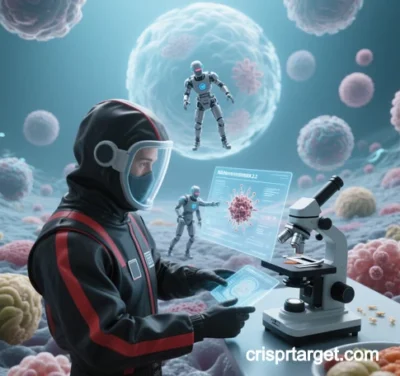
Applications of CRISPR-Target Technology in Food Safety (2025 Update)
CRISPR’s high specificity, sensitivity, and programmability have revolutionized food safety by enabling rapid pathogen detection, toxin screening, authenticity verification, and contamination control. Below are key applications and advancements:
I. Pathogen Detection: Rapid, Sensitive, and On-Site
1. Foodborne Bacteria Detection
- E. coli O157:H7:
- LAMP-CRISPR-Cas12a detects as low as 1.22 CFU/mL in fresh lettuce within 45 minutes.
- Metal-organic framework (MOF) platforms combined with Cas9 target virulence genes for high-sensitivity detection in milk and bottled water.
- Salmonella:
- RPA-Cas12a-FS identifies 10 copies/reaction in meat and milk within 45 minutes.
- Gold nanoparticle colorimetric sensors with CRISPR-Cas12a enable visual detection via ssDNA cleavage.
2. Virus and Parasite Detection
- Norovirus: Cas13a-based SHERLOCK detects 1 copy/μL of viral RNA in shellfish, outperforming traditional PCR.
- Campylobacter jejuni: Immunocapture beads (ICB) with LAMP-Cas12a achieve a detection limit of 8 CFU/mL in 70 minutes.
3. Multiplex Detection
- Microfluidic Paper-Based Chips (μPAD): Integrate RPA and CRISPR-Cas12a for SERS-based detection of Salmonella Typhimurium at 3–4 CFU/mL.
- Multi-Pathogen Screening: Combined Cas12a and Cas13a systems detect Listeria, Salmonella, and viruses simultaneously.
II. Toxin and Contaminant Screening: From Nucleic Acids to Non-Nucleic Targets
1. Mycotoxins
- Aflatoxin M1: CRISPR-Cas12a with aptamer signal conversion detects 0.1 ppb in milk—100x more sensitive than ELISA.
- Ochratoxin A: DNAzyme converts toxin signals into nucleic acid sequences, triggering Cas12a trans-cleavage for instrument-free detection.
2. Chemical Contaminants
- Melamine: Functional nucleic acid (FNA)-CRISPR-Cas12a detects 0.05 ppm in dairy products.
- Heavy Metal Ions (e.g., Pb²⁺): DNAzyme-CRISPR translates Pb²⁺ levels into fluorescent signals with a 0.1 nM detection limit.
3. Antibiotic Residues
- β-Lactams: CRISPR-Cas13a screens for antibiotic resistance genes (e.g., blaCTX-M) to assess risks in food.
III. Food Authenticity Verification: Anti-Counterfeiting and Traceability
1. Meat Adulteration
- Horsemeat in Beef: CRISPR-Cas12a targets species-specific mitochondrial DNA, identifying fraud in 30 minutes.
- Seafood Traceability: Rapid species identification (e.g., tuna, cod) via COI gene analysis.
2. GMO Screening
- Transgenic Soy/Corn: Cas9-lateral flow strips detect 35S promoter/NOS terminator with 0.1% sensitivity.
3. Religious Compliance
- Halal Certification: Portable CRISPR kits target porcine genes (e.g., SRY) to prevent cross-contamination.
IV. Contamination Control and Food Processing Optimization
1. Pathogen Suppression
- Dairy Safety: CRISPRi silences E. coli toxin genes (e.g., stx2), reducing Shiga toxin production.
- Fermentation Security: Phage-resistant lactic acid bacteria engineered via CRISPR prevent fermentation failures.
2. Shelf-Life Extension
- Produce Preservation: Knocking out quorum-sensing genes (e.g., lasI) in spoilage bacteria (e.g., Pseudomonas) inhibits biofilm formation.
- Low-Alcohol Beer: CRISPR-edited yeast reduces ethanol synthesis for healthier brews.
3. Allergen Reduction
- Gluten Sensitivity: Wheat α-gliadin gene edits produce low-allergen flour for celiac-safe products.
V. Smart Packaging and Real-Time Monitoring
1. Live Pathogen Detection
- CRISPR Biosensors: MIT’s Cas12a-fluorescent systems integrate into packaging to detect pathogens or polycyclic aromatic hydrocarbons (PAHs).
2. Smart Labels
- Spoilage Indicators: CRISPR-Cas13a with nanomaterials visualizes food decay via color-changing labels.
3. Cold-Chain Surveillance
- Viral Contamination Alerts: NMPA-approved CRISPR protocols screen for SARS-CoV-2 in冷链 (cold-chain) foods.
VI. Challenges and Future Directions
| Challenge | Solution | Breakthrough |
|---|---|---|
| Non-nucleic target sensitivity | DNAzyme/aptamer signal conversion | Detection limits as low as 0.1 ppb |
| High on-site device costs | Lyophilized Cas RNP kits + mobile readers | Cost per test <$1 |
| Regulatory delays | EU Gene-Edited Food Testing Standards | 12 CRISPR methods approved by 2025 |
| Public acceptance | Open-source tech + transparent risk assessment | WHO CRISPR Food Safety Guidelines |
Conclusion and Outlook
CRISPR-Target technology is transforming food safety from lab-based to on-site and AI-driven systems:
- Tech Integration: AI tools like DeepCrop optimize sgRNA design, slashing detection cycles from 3 days to 1 hour.
- Industry Adoption: Over 50% of global dairy firms deploy CRISPR pathogen screening, reducing recall costs by 70%.
- Sustainability: CRISPR-engineered plastic-degrading bacteria co-produce biofuels, closing the “pollution-to-energy” loop.
By 2030, CRISPR is projected to dominate 80% of food safety testing scenarios and become central to smart packaging, driving the global food industry toward zero contamination, full transparency, and climate resilience.
Data sourced from public references. For collaboration or domain inquiries, contact: chuanchuan810@gmail.com.




